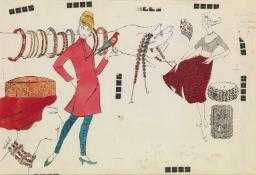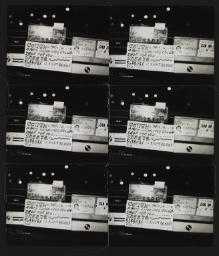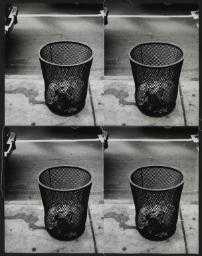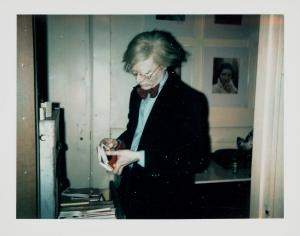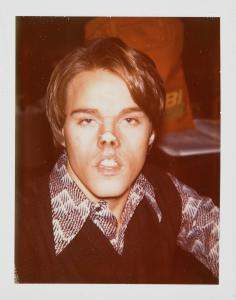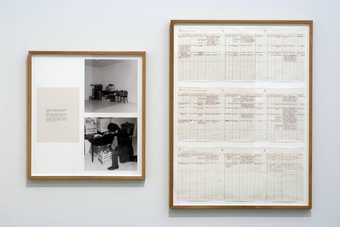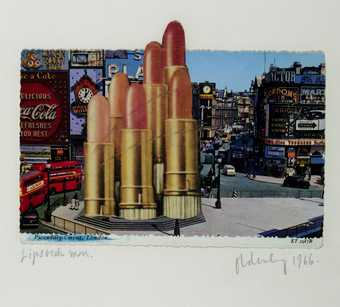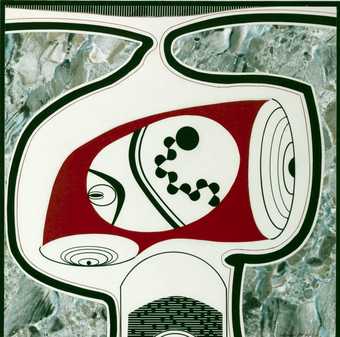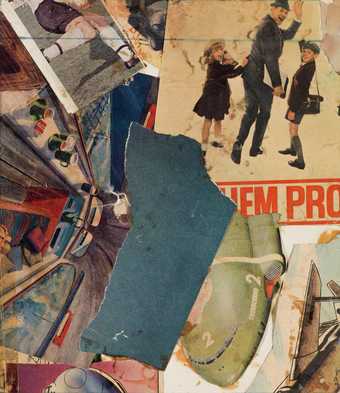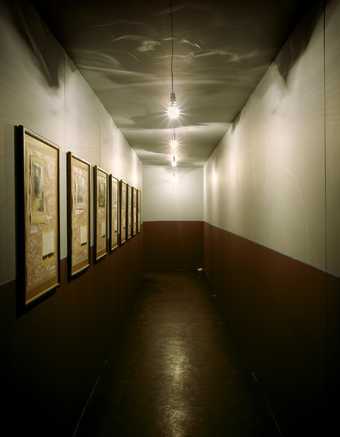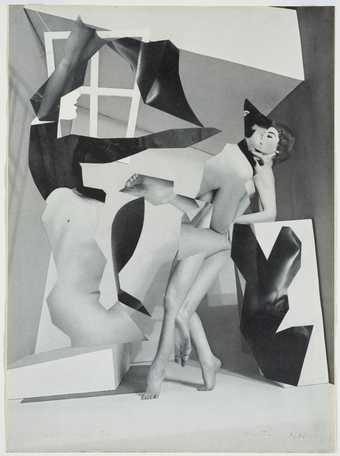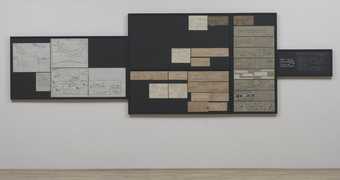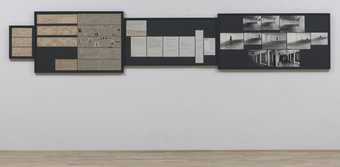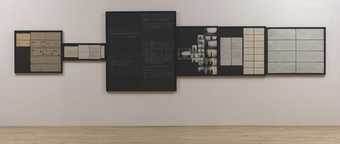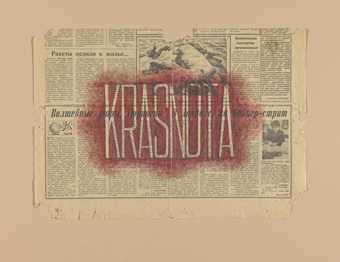
Not on display
- Artist
- Vito Acconci 1940–2017
- Medium
- 6 works on paper, photographs, ink and printed papers
- Dimensions
- Support: 858 × 992 mm
support: 857 × 680 mm
support: 350 × 812 mm
support: 578 × 731 mm
support: 1110 × 1391 mm
support: 1148 × 896 mm - Collection
- Tate
- Acquisition
- Presented by the Billstone Foundation 2009
- Reference
- T13178
Summary
Sonnabend Show Jan 72: Archives is a major work comprising documentation of three linked performance installations Acconci presented at the Sonnabend Gallery, New York in January 1972. The project consists of four parts, each of which is a multi-panel work comprising photographs, drawings and notes. Three of the four sections describe and illustrate the specific performances, titled Seedbed, Transference Zone and Supply Room respectively. An overview section describes the genesis of the three performances.
At the time of Acconci’s 1972 exhibition, the Sonnabend Gallery had three exhibition spaces: two main galleries and a smaller transition area next to the reception desk. When he began planning his exhibition, Acconci conceived of separate live actions to activate each of these spaces. Each performance was conducted at certain times during the run of the three-week show.
Of the performances, Seedbed is the most famous, and has become recognised as one of the most important live artworks of the 1970s. In an otherwise empty gallery a ramp was constructed over the floor extending from the centre of the gallery to the back wall. During the times the work was activated, on Wednesdays and Saturdays during the exhibition, Acconci positioned himself in the confined space under the ramp and repeatedly masturbated, using the sound of visitors walking above him to fuel his sexual fantasies. He spoke into a microphone and his onanistic monologue was conveyed to the visitors through speakers installed in the corners of the gallery. Acconci has described the performance: ‘My voice comes up from under the floor: “you’re pushing your cunt down on my mouth… you’re pressing your tits down on my cock… you’re ramming your cock down into my ass…” (Now and then, you can hear me come: I’ve done this for you, I’ve done this with you, I’ve done this to you…)’ (quoted in Gloria Moure, Vito Acconci: Writings, Works, Projects, Barcelona 2001, p.154).
Transference Zone was enacted in the other large gallery space. At one end of the gallery was a waiting area with chairs and rugs. The opposite corner of the space housed a small constructed room which the artist refers to as an ‘isolation chamber’. The chamber housed photographs of seven people who had an important place in the artist’s life, and possessions belonging to these ‘prime people’. When conducting the performance on Tuesdays and Fridays, Acconci locked himself inside the isolation chamber, immersing himself in the images and objects related to one of the ‘prime people’. If a viewer chose to knock on the door and the artist was alone, he would invite them in, responding to the visitor as if he or she were the ‘prime person’. Acconci has described his intention: ‘my hope is that, if I’ve convinced myself thoroughly enough, the viewer might start to respond the way the “prime person” would have responded – the viewer might fall into my history, “become” the prime person’ (ibid., p.156).
Supply Room took place on Thursdays and was performed by Acconci and his companion Kathy Dillon, who had previously collaborated with him on a number of other works, including Applications, 1970; Pryings, 1971 and Remote Control, 1971. One corner of the space was screened off by fine green netting hung floor to ceiling; the opposite corner housed drums, cushions, crumpled black netting, and a tape recorder. When the performance was activated Acconci stood behind the green netting, wearing a blindfold. Dillon sat behind the drums. Her voice was audible on a pre-recorded monologue played through the tape recorder, inviting women entering the space to kidnap Acconci and make him their prisoner.
Acconci conceived of the three performances as related parts of a whole. He has written:
Since the three spaces are part of one gallery, one space can’t help but be seen in relation to the other. In Room A (Seedbed), I’m under the floor, I’m part of the architecture of the room, whereas in Room C (Transference Zone), I’m inside a point, a booth, in the corner, whereas in Room B (Supply Room), I’m there only so that I won’t be there, only so that I can be taken away, only so that I can be kidnapped.
All the rooms are stopping-off places (I’m not here all the time, I come here only at certain times during the length of the gallery show). Room A is the present (Seedbed: I can have a relation now, I can’t even see you, there are no strings attached), whereas Room C is the past (Transference Zone: prime people in my life), whereas Room B is the future (Supply Room: Kathy’s life without me).
(Quoted in correspondence from David A. Ross, Albion Gallery, 21 July 2008.)
The Sonnabend exhibition represented a key moment in the articulation of Acconci’s practice, highlighting the importance of reciprocal interaction with the viewer. The physical manifestation of each of the performances reflected Acconci’s sustained interest in the interplay between the psychological and the social, expressed in structures that emphasise the overlapping boundaries of interior and exterior. These theoretical concerns have been crucially important in the development of art since the 1970s, and can be seen not only in Acconci’s own move towards architectural practice, but more broadly in the rise of relational art in the subsequent decades.
Further reading
Kate Linker, Vito Acconci, New York 1994.
Gloria Moure, Vito Acconci: Writings, Works, Projects, Barcelona 2001.
Frazer Ward, Mark C. Taylor and Jennifer Bloomer, Vito Acconci, London 2002.
Rachel Taylor
December 2008
Does this text contain inaccurate information or language that you feel we should improve or change? We would like to hear from you.
Display caption
Transference Zone was enacted in one of the Sonnabend’s large exhibition spaces. At one end was a waiting area with chairs and rugs. In the opposite corner stood a small ‘isolation chamber’, housing photographs of seven people who had an important place in the artist’s life, and possessions belonging to them. Acconci locked himself inside, immersing himself in the images and objects related to one of the ‘prime people’. If a viewer knocked on the door and the artist was alone, he would invite them in, responding to the visitor as if he or she were the ‘prime person’.
Gallery label, March 2011
Does this text contain inaccurate information or language that you feel we should improve or change? We would like to hear from you.
You might like
-
Andy Warhol Female Figures and Fashion Accessories
1960 -
Andy Warhol Cough
1986 -
Andy Warhol Trash Cans
1986 -
Andy Warhol Little Red Book #132
1971–2 -
Andy Warhol Little Red Book #257
1972 -
Vito Acconci Room Situation
1970 -
Claes Oldenburg Lipsticks in Piccadilly Circus, London
1966 -
John Berry [no title]
1969–71 -
Barry Martin Movement Collage
1965 -
Ilya Kabakov Labyrinth (My Mother’s Album)
1990 -
Marcel Mariën Sculpture Friends
1974 -
Vito Acconci Overall Show
1972 -
Vito Acconci SEEDBED
1972 -
Vito Acconci SUPPLY ROOM
1972 -
Dmitri Prigov Redness Will Save the World
c.1987–9

